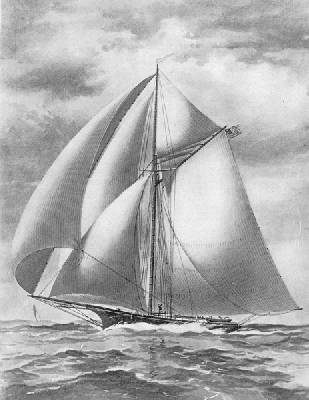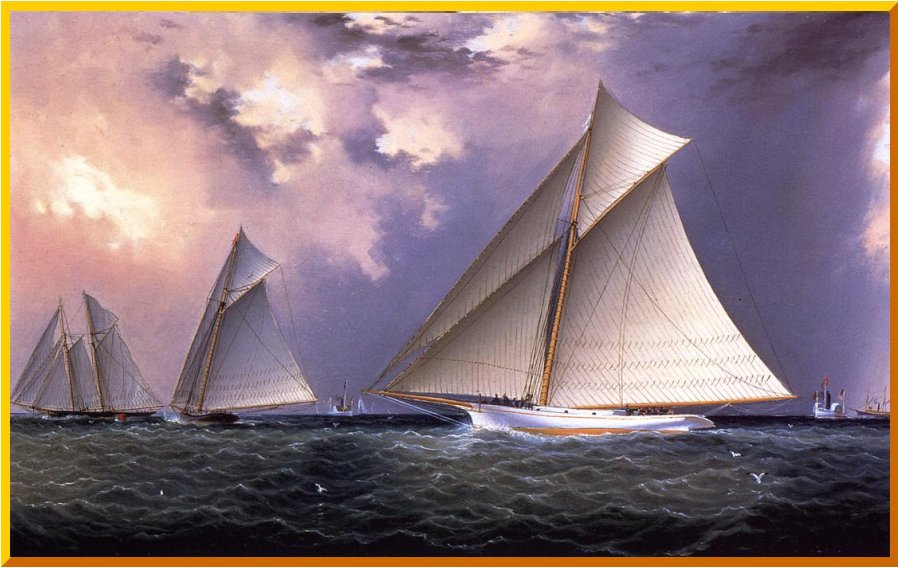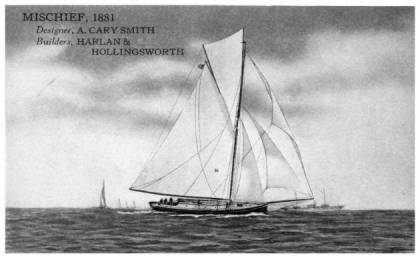Yves GARY Hits: 5994
Category: 1881 : CHALLENGE N°4
 Four Sloops for one defender
Four Sloops for one defenderThe preparations for the contest involved a departure which marked the birth of the custom of building boats specially to defend the cup, though, as events transpired, the defence that year was made by a boat not built for the purpose.
In canvassing the list of American boats fast enough to put against the Canadian challenger, the New York Yacht Club decided that the sloop Arrow was the most desirable.
 She was of David Kirby's build, but being owned by a non-member of the New York Yacht Club, Mr. Ross Winans, of Baltimore, she was not considered available.
She was of David Kirby's build, but being owned by a non-member of the New York Yacht Club, Mr. Ross Winans, of Baltimore, she was not considered available.
While the question of buying the Arrow was being debated by members of the New York Yacht Club, Mr. Kirby, hearing of the needs of the club, agreed to build a boat faster than the Arrow. He was given a contract to do so, by the flag officers of the club, John R. Waller, Commodore, James D. Smith, Vice-Commodore, and Herman Oelrichs, Rear-Commodore.
The result was Pocahontas. She was a centre-board sloop, 72 feet 6 inches over all, 65 feet water line, 21 feet 6 inches beam, 7 feet 10 inches depth, and 6 feet and 7 inches draft, a typical old-fashioned single-sticker, built from a model whittled out, and scaled by the eye. She presented an inconsistency often noted in rule-of-thumb models, one part of her, the bows, being fine and fair, while another part, the counters and stern, was heavy and crude. She was also oversparred, and developed no speed, her racing career being confined to three trial races.
The first trial race took place October 13th, 1881, the competing yachts being the sloops Gracie, Hildegard, Mischief, and Pocahontas. Hildegard and Pocahontas lost their topmasts, and Mischief beat Gracie.
The second trial took place on October 19th, and, Hildegard withdrawing, Gracie beat Mischief 3 m. 49 s., Pocahontas being distanced.
Mischief and Gracie America's Cup Trial Race, 1881
James E. Buttersworth
Next day Mischief beat Gracie by 14 s., Pocahontas again being far behind. The showing made by this first yacht built for cup defence was a great disappointment to her owners, but they took their ill fortune with commendable philosophy, and Pocahontas was promptly retired, to enter on an unsung career as a cruiser. She is still afloat, and in 1901 was enrolled in the New York Yacht Club fleet, after an absence from the club list of some years.
 The choice
The choiceGracie, owned by Charles R. Flint and Joseph P. Earle, and Mischief, owned by J. R. Busk, were fast and able boats, the pick of their kind, and there was great rivalry between their owners as to which should defend the cup. The honor fell to Mischief, notwithstanding her owner, Mr. Busk, though a New York Yacht Club member, was an Englishman, and not a naturalized citizen of this country.
The committee did not consider this circumstance ground for barring Mischief, being influenced in its choice of the boat by the fact that she had to allow the challenger only about three minutes, whereas Gracie would be obliged to concede an allowance of about eight minutes. The selection led to acrimonious communications to the press from the owners of Gracie.
